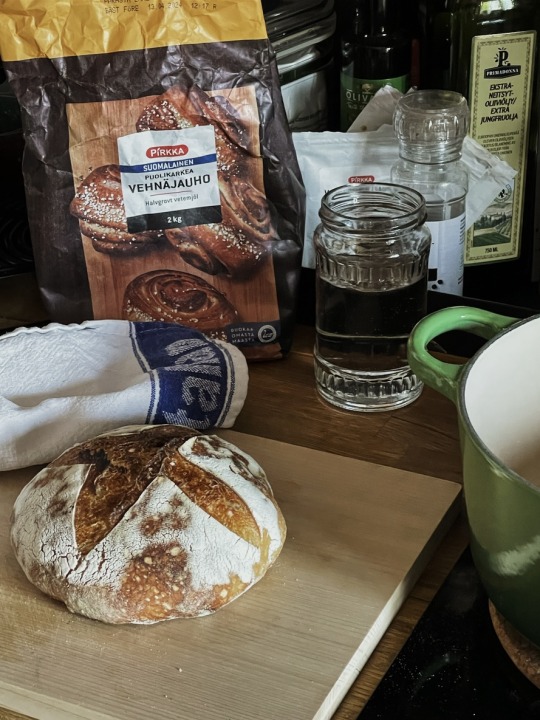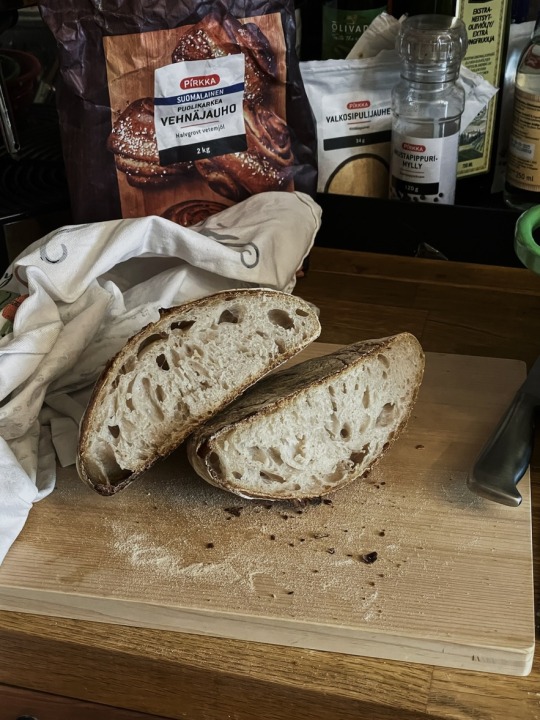#like some professionals even make 100% hydration doughs)
Explore tagged Tumblr posts
Text


2nd batch of sourdough! Lots better than the first, actually got some crumb structure this time (bc the starter is finally ready for bread)
#it's 70% hydration 20% starter and 16h bulk fermentation & 6h of proofing#I think I like the 70% hydration for now#it's still enough moisture to get that open structure but easy to work with#(hydration is the thing that makes the crumb structure open&tender so kind of the higher hydration dough u have the better the bread but th#problem with high-hydration dough is that it's real hard to work with so gotta build some skills before can move onto those#like some professionals even make 100% hydration doughs)#(the percentage is like how much water you have in comparison to the flour: 100% is like if u have 500g of flour you also have add 500g of#water or like 70%: 500g flour and 350g of water)#this is just a 250g of flour one tho bc I live alone and don't want waste/my freezer full of bread#idk if these interest anyone but idc it's my blog I'm going to be posting abt sourdough#should make up a tag for these#elvis bread#it's that one ^^ for now until (if) I can come up with a better one bc my starter is named Elvis#sourdough#april 2024#2024
129 notes
·
View notes
Text
How to make dry yeast
Dried yeast is one of the wonders of modern baking — a pourable granular powder made from millions of millions of dehydrated unicellular organisms. After hydration, these small critters munch on the sugar or starch in a dough, producing alcohol and carbon dioxide, which give the bread its distinctively fermented taste and its airy rise.
Successful resurrecting of dry yeast depends entirely on the processing. So if a recipe requires a certain type, the instructions are tailored to their specific needs. These instructions can kill another type of dry yeast, or they fail to create the conditions for it to thrive, causing doughs to rise poorly — or doughs that do not even brew. This means that it is important for bakers to understand the language used to describe the different types of dry yeast and to realize that blind substitution is a crapshoot at best. Some recipes, especially high-moisture dough and short post-fermentation, can provide a hospitable environment for many types of yeast and create a false sense of security around substitution.
Most common types of dry yeast
Bread baking can be complicated, which is partly due to all variables when using yeast. There are several types of yeast that you can use in baking, but two of the most common are active dry yeast and instant yeast, also called rapid rise yeast. Instant Yeast and Active Dried Yeast include some of the same preparation steps, but your overall baking time gets shorter with Instant Yeast as it can significantly shorten the time it takes for the dough to rise.
Active Dry Yeast
As the name implies, active dry yeast must be “activated” by dissolving the granules in warm water according to the packing instructions. (The peculiarities may vary from brand to brand, in some cases, sugar can be added as fuel for the yeast.) When the yeast is still alive, it will start to foam and grow within a few minutes.
Active dry yeast is so unstable that any given packet may be dead. You must, therefore, check whether it is still alive or not before proceeding with the recipe, even if the yeast has not yet reached the expiration date stated on the package. Active dry yeast also has a comparatively large grain size, further necessitating direct contact with warm water to dissolve. Due to this time-consuming step as well as the high risk of failure and high failure costs, active dry yeast is seldom used in a professional environment. When the yeast is still alive, it starts to foam and grow within a few minutes.
· Dry yeast is perishable very quickly. Always check the expiry date before use.
· The effectiveness may vary over time and lead to inconsistent results
· Must be rehydrated before use
· Easily damaged by liquids above 46 ° C (115 ° F)
· Suitable for recipes that require more than one boost
· Suitable for cold-resistant doughs
Instant dry yeast
Thanks to its unique manufacturing process, instant yeast is guaranteed to be 100% active and can be used immediately from the packaging. The behavior is constant over time. Due to the small grain size, instant yeast dissolves easily in the ambient moisture of a dough, so that no rehydration is required. Because of their stability and shelf life, instant yeast is safe to buy in bulk, dramatically reducing costs compared to the tiny packs of active dry yeast sold in stores.
· Very stable; can be frozen for several years
· Consistent behavior over time
· Tolerant at temperatures up to 130 ° F (54 ° C)
· Suitable for recipes that require more than one boost
· Suitable for cold-resistant doughs
How To prepare Dry Yeast
Put four ounces of hops on six quarts of water; Boil it up to three quarts. Strain, boiling hot (as directed for the soft yeast) on three pints of flour, a large spoonful of ginger, and another of salt. a large spoonful of ginger and another salt. When it’s cool, add a pint of sweet yeast. When it is foaming lightly knead in sieved Indian meal so that it becomes very stiff. Make it into loaves, cut into thin slices and place it on clean boards. Put it on a free stream of air in the sun. If a side has dried to be a bit crispy, turn the slices over; and if both sides are dry, break them up into small pieces. It dries sooner than if not broken. Put it in the sun for two or three days in a row. Stir it by hand often, so that all parts are equally exposed to the air. When it is completely dry, put it in a coarse bag and hang it in a dry and cool place. The greatest inconvenience in the production of this yeast is the risk of cloudy or wet weather. If the day after production is not fair, you must put the glass in a cool place and wait a day or two before inserting the Indian meal. But the best yeast is made when the weather stays clear and dry. and if it’s a bit windy, so much the better.
Take a handful for five loaves of bread; soak it in very little water until it is soft, which will be in a few minutes; Stir it into the sponge prepared for the bread. This yeast makes less tender bread than the soft type but is very practical.
How to use dry yeast
Here are some tips to make the most of your dry yeast.
· Keep it cold. Dry yeast tolerates storage at room temperature better than liquid yeast. But if you keep it cold, viability improves even longer. Store it just like your liquid cultures.
· Hydration is the key. Dry yeast should always be rehydrated in a little lukewarm water before pitching. Some brewers just sprinkle dry yeast on fresh spice and call it good, but it’s more stressful for the yeast. Hydration prior to pitching promotes optimal numbers of healthy cells.
· Aeration is optional. During the drying process, the yeast manufacturer absorbs important nutrients needed for cell growth. Dry cultures can, therefore, be puffed to low-oxygen wort. Aeration won’t hurt but is not necessary.
Dry yeast strains generally work better for malt and hop styles than for those that rely on yeast driven complexity Pale Ale, IPA, Stout, Porter and Brown Ale are good for dry yeast fermentation.
https://fadayeast.com/product-category/brewer-yeast-alcohol-yeast/
0 notes